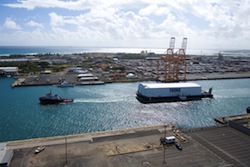The Port of Honolulu is moving to portable hydrogen fuel cells by 2015. The move to the emerging technology comes on the heels of a 2013 study and analysis that confirmed the viability of hydrogen fuel cells to provide auxiliary power to docked or anchored ships.  Hydrogen researchers at Sandia National Laboratories have joined with several partners in the project, which will result in a portable, self-contained hydrogen fuel cell unit that can float on a barge, sit on a dock or be transported to wherever it’s needed to provide electrical power.
Hydrogen researchers at Sandia National Laboratories have joined with several partners in the project, which will result in a portable, self-contained hydrogen fuel cell unit that can float on a barge, sit on a dock or be transported to wherever it’s needed to provide electrical power.
The next phase of the fuel cell demonstration project led by Sandia National Laboratories will feature a portable, self-contained hydrogen fuel cell unit currently in the design phase. Once completed, it will be deployed to the Port of Honolulu by Young Brothers, Ltd., one of the project partners and a primary shipper of goods throughout the Hawaiian Islands. The unit is undergoing detailed engineering and design through mid-2014. After fabrication, assembly and training for Young Brothers operators, the hydrogen fuel cell unit will be operational during a six-month deployment in early 2015.
“No one has ever built this kind of custom unit for this purpose,” said Sandia’s project manager, Joe Pratt. The unit, he said, will fit inside a 20-foot shipping container and will consist of four 30-kilowatt fuel cells, a hydrogen storage system and power conversion equipment.
Ports have been a major source of water and air pollution in the U.S. but remained relatively unregulated until recent years. As ports have begun to expand and their impact on the environment has become more apparent, port operators face a variety of regulations. Many ports have begun to enact sustainability goals or adopt green practices, and that’s where fuel cells can play a role.
The Hawaii project is jointly sponsored by the U.S. Department of Energy’s Office of Energy Efficiency and Renewable Energy (EERE) and by the U.S. Department of Transportation’s Maritime Administration (MARAD).

